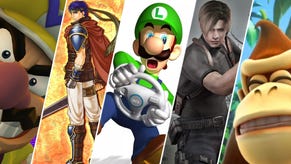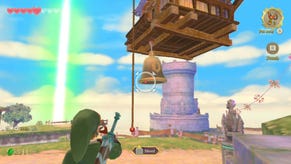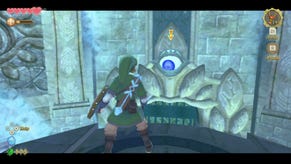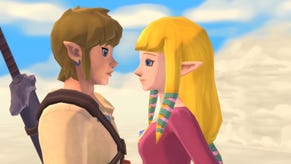Swing king - Hands-on with Zelda: Skyward Sword
Link’s latest adventure is a playground of pretty pinks and vibrant violets but, as everyone knows, you shouldn’t judge a book by its cover. So, is the series growing up or dumbing down? VG247 spent time finding out.
You have to enjoy the little things.
The template for Zelda games has long been fixed in the minds of its creators and gamers alike. Whilst some argue that the format needs updating - that the series must be taken in a new direction and made more dynamic - there are those who steadfastly believe that to significantly alter the template on which Link’s adventures are so meticulously built would be to destroy its magic; to make it something less than it currently is.
And so, each iteration makes just small tweaks to the formula, maintaining the sacred core and succeeding precisely because that core was so brilliantly designed in the first place.
Based on hands-on time with Skyward Sword, which served to scratch the surface of Link’s latest odyssey, the numerous tweaks and additions that have been made and overlaid on the core mechanics are surprisingly simple and for, most part, exceedingly effective.
Judging a book by its cover
Skyward Sword’s lighter hues and more vibrant palette are amongst the first things to be noticed. Entering the central chamber of a temple, the area is flooded with light from the high domed-ceiling and it reminds me that most of my prominent memories of Twilight Princess are of muted, dusky scenes - as if Nintendo had been trying to enforce Link’s maturity through its colour-scheme.
Here, the candy-cane shades and watercolour-washed visuals are more reminiscent of one of Kirby’s adventures. But it’s refreshing and, for those whose small white box sits next to the more frequently used bulk of a PS3 or 360, the more deliberately-stylised softer edges will help soothe eyes used to viewing digital worlds rendered in the stark relief of HD; eyes that might otherwise recoil from the lower resolution building-blocks from which this world is sculpted.
Control of Link has undergone subtle changes, and it’s here that the first whispers of a quiet revolution can be heard. Something as banal as an equipment selection process rarely excites people and is usually only noticed when its particularly poorly designed, but Skyward Sword has seen a redesign in this area and it’s improvement of the kind that you cannot believe hasn’t been made before. Two radial menus: one for equipment, one for potions can now be accessed on-the-fly.
Big whoop, huh? Doesn’t sound like much, does it? You’d be surprised just how much difference it makes to freedom of control, however. Gone is the stop-start nature required by dipping in and out of the menu. Even Twilight Princess - which allowed you to map four items to quick slots – still paused the action when you opened its own radial menu to assign items to buttons.
Here, everything keeps moving, Link remains under your control via the analogue stick whilst you point and snap equipment into place. It shows potential for a more seamless, uninterrupted experience and allows for quick-paced changes of tactics during battle – ushered in by a simple design change.
It shows potential for a more seamless, uninterrupted experience.
Combat, too, has been tweaked and the closer approximation of 1:1 movement afforded by Motion Plus has enabled more cleverly and interestingly designed enemies to be implemented.
Sword slashes can be made in eight compass point-directions along with a forwards jab, and even some low-level enemies require a mix of these attacks in order to hit their exposed, un-armoured side. Carnivorous plants require a horizontal or vertical slash to correspond to the gape of their open maw and hanging spiders require a sideways blow to spin them and a well-timed jab at their exposed underbelly.
Holding the Wii remote in front of you sees Link mimic your action with his sword and keeping the remote steady charges up a focused attack. Certain enemies will intently watch the position of your sword and must be disorientated with a swirling motion before striking them whilst they’re dizzy.
These changes to sword play, along with the on-the-fly item selection, allow for a more dynamic approach to combat. Furthermore, you’re no longer rooted to the spot when aiming weapons, and so the likes of the slingshot and bow become useful parts of your arsenal, even against more nimble assailants, rather than being tools for solving puzzles or weapons to be used against stationary foes.
The result is combat that feels more fluid and flexible than that found in any previous Zelda title; the added depth dispelling any misplaced concerns caused by the child-friendly aesthetics that this is a game for kids.
Where does he get those wonderful toys?
By far the most enjoyable of the new toys on offer during the hands-on is the mechanical beetle. The tilt and pitch of this flying scout is controlled by the remote and can be used to trigger out of reach switches, collect Rupees and, once upgraded, to grasp objects. Its flight appears to be restricted to 30-second stints before it returns to you but it’s a genuine pleasure to be able to explore hidden nooks and crannies and it feels, in the franchise’s own unique way, like an adventure in itself.
Despite the general feeling of freedom talked about so far, there are some gripes about the control system. It stems, really, from the simple fact that much of what’s being done here could be achieved with the analogue sticks of a standard controller and that, whilst it’s a part of the Wii’s unique genetic makeup, it always feels like something of a novelty; an alternative to, rather than an improvement on, more traditional control methods.
There are some minor instances where some of the controls feel tacked on, too: balancing Link on a tightrope that, for example. Instead of this being achieved via the more intuitive method of Motion Plus – like the beetle - it’s controlled via the pointer and if the best laid plans fail during combat and you end of waggling for your life, the accelerometer in the remote can become out of sync and take a second or two to realign.
In truth, these criticisms can be levelled at the Wii’s entire catalogue of games, not just at Skyward Sword and, on balance, the improvements over Twilight Princess’ control scheme are plain to see.
For so long as Nintendo continues to consistently deliver charming re-imaginings based on the same golden template, its fans will continue to explore each game as though it were an entirely new entity.
There’s long been an unwritten contract between Nintendo and fans of the Zelda franchise, one that has maintained balance and been facilitated by the high production values and exemplary design of the series. A contract that states that, for so long as Nintendo continues to consistently deliver charming re-imaginings based on the same golden template, its fans will continue to explore each game as though it were an entirely new entity and be delighted all over again from scratch. And marvel at every rediscovery of the boomerang.
From game to game it’s the little things that change.
And you have to enjoy the little things.
The Legend of Zelda: Skyward Sword launches on Wii later this year.












